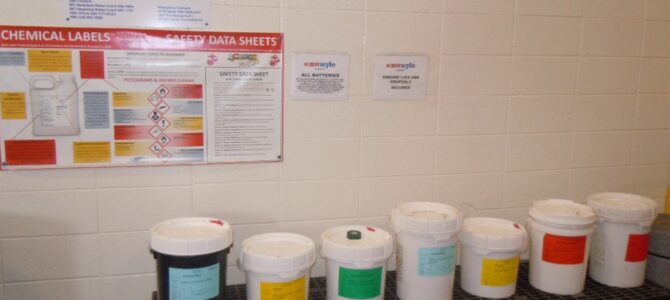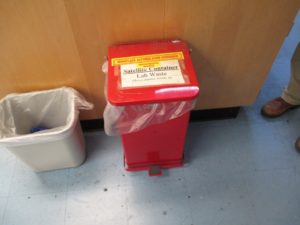The Federal regulations of the U.S. Environmental Protection Agency (USEPA) and those of all states limit the amount of time a hazardous waste generator may accumulate hazardous waste on-site without requiring a permit for the facility to operate as a treatment, storage, or disposal facility (TSDF). In general, the on-site accumulation time limits for hazardous waste in a central accumulation area (CAA) are as follows:
- Large quantity generator (LQG) is allowed no more than 90 days for the on-site accumulation of its hazardous waste. A 30-day extension may be granted in extreme situations.
- Small quantity generator (SQG) is allowed no more than 180 days for the on-site accumulation of its hazardous waste. This may be extended up to 270 days if the TSDF the SQG must use is 200 miles away or more. A 30-day extension may be granted in extreme situations.
- Very small quantity generator (VSQG) has no on-site accumulation time limit for its hazardous waste.
|
Not sure of your hazardous waste generator category? |
If you look for the SAA regulations at their old location of 40 CFR 262.34(c), you won’t find them. The Generator Improvements Rule – along with other revisions – changed the location of the SAA regulations to 40 CFR 262.15. Read: Reorganization of the Federal Regulations According to the Generator Improvements Rule
The LQG and SQG have the option to manage their hazardous waste in a satellite accumulation area where it is subject to less regulation. The VSQG has no use for SAAs since it is already subject to a lower-level of regulation than either the LQG or SQG. Examples of less regulation within a SAA v. CAA include:
- Hazardous waste personnel training for a LQG at 40 CFR §262.17(a)(7) is not applicable to personnel who manage hazardous waste solely within a SAA.
- Weekly inspections for both LQG [§262.17(a)(v)] and SQG [§262.16(b)(iv)] are not required for hazardous waste containers in a SAA.
- The RCRA air emission standards for a LQG at §264/§265, Subpart CC are not applicable to hazardous waste containers in a SAA.
- In the not-so-distant past (before May 30, 20217), the regulations for preparedness, prevention, and emergency procedures for both LQG and SQG were not applicable to hazardous waste accumulated in a satellite accumulation area. However, under the revised regulations of the Generator Improvements Rule, this has now changed.
- And, of course, the most significant benefit to a hazardous waste generator for accumulating hazardous waste containers in a SAA: no on-site accumulation time limit – unless you operate in California!
In its Final Rule of the Generator Improvements Rule, USEPA included a succinct description of the SAA [November 28, 2016; 81 FR 85762]:
Hazardous waste generators are allowed, though not required, to use SAAs, provided that they comply with the regulations for their use. SAAs are designed to assist generators who generate and accumulate small amounts of hazardous waste in different areas of their facility. Alternatively, SQGs and LQGs may choose to accumulate hazardous waste only in CAAs rather than in SAAs. If a SQG or LQG does choose to accumulate hazardous waste in a SAA, the generator may accumulate a limited amount of hazardous waste within each SAA. Once that threshold is reached, the SQG or LQG must transfer the hazardous waste to a CAA. Alternatively, a generator may accumulate hazardous waste within a SAA and never move the waste to a CAA once the threshold is reached, but instead, ship the waste directly off site to a RCRA designated facility (e.g., a TSDF).
Limitations and restrictions when accumulating hazardous waste in a SAA include:
- The only allowed hazardous waste accumulation unit is the container. No tanks, drip pads, or containment buildings.
- Container must be under the control of the operator generating the waste.
And…
- At or near the initial point of generation.
- May accumulate no more than 55 gallons of hazardous waste in a SAA.
And…
- May accumulate no more than 1 L or 1 kg of acute hazardous waste in a SAA.
- When the threshold volume is reached the generator has three consecutive calendar days to remove the excess amount from the SAA to the CAA or transport off-site.
|
Contact me with any questions you may have about the generation, identification, management, and disposal of hazardous waste Daniels Training Services, Inc. 815.821.1550 |
Conclusion:
The satellite accumulation area (SAA) may be used as an option for on-site accumulation of hazardous waste in containers at a LQG or SQG. No option exists for the LQG to provide initial Hazardous Waste Personnel training with an annual review to its employees who work with or manage hazardous waste – except, of course, for those whose only exposure to hazardous waste is in a satellite accumulation area.

